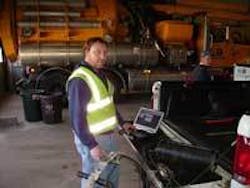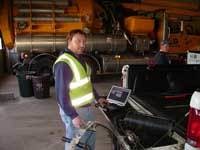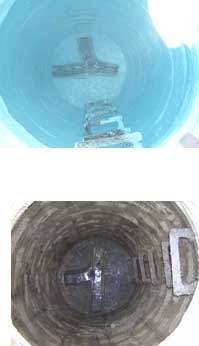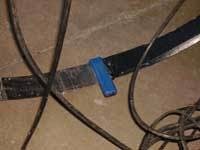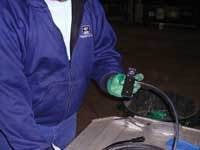In Naperville: New Flow And Level Sensors Help Find Sources Of Major Extraneous Flows
Naperville, Ill., has been one of the fastest growing communities in the U.S. in recent times. Not only has the city’s wastewater collection system undergone tremendous expansion, it experiences significant hydraulic loadings. In addition, much of the city’s older clay lines, some installed as early as the 1920s, are rapidly deteriorating. Therefore it is critical that a well-planned approach be taken to reducing I/I to avoid overloading the system, which can result in higher treatment costs, excessive pumping costs and increased pump wear.
Cost-Effective, Long-Term Flow Monitoring
Naperville has developed a flow monitoring program that provides real-time “snapshots” of the current conditions of the collection system, which includes 469 miles of sewer lines with 19 pump stations. Through this continuous monitoring, the Naperville Department of Public Utilities’ Water Distribution & Collection Division identifies, isolates, and ultimately rehabilitates those portions of the system that are contributing the most to the I/I problem.
“Our system has 24 permanent sites and 10 temporary sites where we monitor flows,” says Tony Conn, Department of Public Utilities field supervisor. “Two of our permanent monitoring sites are for measuring flows from Warrenville, for billing purposes. The rest we use primarily for I/I monitoring and for helping us determine I/I versus rehab costs.”
Conn says that with the permanent meters in position, his department knows what sanitary service main lines have the most serious I/I problems.
“Then we break these areas down further into smaller sections using our temporary flow meters, and we keep these in place during the entire duration of the rehab process. With the information our flow monitors provide us, we compare the flows in these sections before and after rehab and can also easily determine the amount of I/I we knocked off at what cost of rehab.”
By isolating only those portions of the system that flow measurement has shown make the greatest contribution to the I/I problem, resources can be directed where they will be most beneficial. In addition, continuous flow measurement at key locations throughout the system give the department an accurate indication of system integrity, providing important information in prioritizing maintenance tasks.
Upgrading Flow & Level Sensors
Choosing the right flow and level sensors for continuous measurement in harsh conditions without drift or fouling is critical. Naperville is currently replacing many of its older sensors with new Hach Sigma AV flow and level sensors. The newly installed sensors have been specially developed to withstand harsh environments typical of collection systems. For Naperville, the primary reasons for changing out the sensors was to eliminate sensor fouling and sensor drift.
“We had several monitoring sites in particular that caused us nothing but grief due to sensor drift and fouling,” says Conn. “Some of these older units were installed in lines that have slow velocities and heavy silt loading.” This resulted in excess sensor fouling and sensor drift and brought the department a lot of headaches. About every two weeks technicians had to clean the sensors that had fouled or level-adjust the sensors that were drifting - both time-consuming procedures, especially in confined space environments.
The robustness of the Hach Sigma AV sensors can be attributed, in part, to their interchangeable level sensor cover plates that allow the units to adapt to a variety of site conditions. In six of its permanent monitoring sites, Naperville installed the new AV sensors equipped with oil-filled cover plates, designed for use in sites susceptible to extreme fouling. With these units, the sensor cavity is filled with high-viscosity silicon oil that prevents fouling for as much as a year and can be easily replenished on site, if needed.
“Our new sensors provide us more accurate data between longer maintenance intervals, and there’s no sensor drift. We’ve never had to adjust them once, and some of them have been installed since June 2004,” says Conn. “This is saving us on maintenance costs because we don’t need to visit the sites as often. I also like the sensor’s one point calibration.”
Accuracy Brings New Confidence
The Naperville Department of Public Utilities has found that the new flow and level sensors provide strong, clean velocity signals across a wide range of flow situations, including the highly diluted streams present due to infiltration. The AV sensors have larger acoustic crystals and higher frequency than the city’s former units, providing strong echo signals from particles resulting in exceptional accuracy and repeatability.
“The accuracy and reliability of our data is far better than before,” says Conn. “Because there’s no sensor drifting, we have much more confidence in our data. That’s very important, because if the levels are wrong even just a little bit, a little wrong can mean a tremendous amount of water with a system like ours that is taking in millions of gallons a day.”
The city plans to replace all its permanently mounted flow and level sensors with new Hach Sigma AV sensors. From this data, scattergraph plots of the depth and velocity readings reveal the hydraulic conditions in the sewer system, and can reveal bottlenecks and obstructions.
“We’ve reduced a tremendous amount of I/I,” says Conn. “In the areas that we have been working, the payback in rehabilitation costs is about eight years. Also, a $6 million treatment plant expansion will not be necessary because flows have been reduced.” WW
About the Author:
Jim Caruso is Product Application Specialist, Flow and Sampling, for Hach Company, Loveland, Colorado. He can be reached at 970-663-1377 ext. 2828, [email protected].
